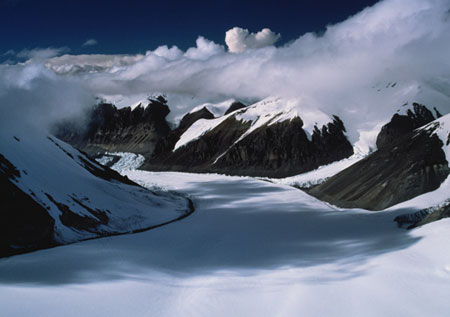A glacier slide that tore a path of destruction through western Tibet last month could have been set in motion by climate change and similar disasters could be ahead.
上個月冰川滑動在西藏西部形成了破壞通道,這可能是氣候變化造成的,以后還會發生同類災害。
The deadly avalanche on July 17 killed nine people and hundreds of sheep and yaks in Rutog County where residents rely on their livestock to survive. It started when a glacier began to slip down a narrow gully between two mountains, sliding over 5 kilometers into the nearby Aru Co Lake. The avalanche covered an area of nearly 10 square kilometers with snow up to 30 meters deep. Nature magazine called it one of the largest ice avalanches in recorded history, comparable only to a 2002 glacier slide that killed 140 people in Russia.
7月17日那場致命的雪崩使九人遇難,并且掩埋了幾百只日土縣居民們賴以生存的綿羊和牦牛。災害開始時,一塊冰川從兩座山之間的狹溝向下滑動,滑行五千多米后進入附近的阿魯湖。雪崩覆蓋面積約10平方千米,積雪厚達30多米。自然雜志稱其為歷史記錄中最大的冰崩,與其相似的只有2002年俄羅斯那場導致140人死亡的冰川滑動。

The immediate cause of the avalanche was clear. But what caused the glacier's slide? Tian Lide, director of a Chinese Academy of Sciences observation center near the avalanche site, says the Rutog avalanche started on flat terrain instead of an incline, making the glacier's sudden slide unusual.
導致雪崩的原因很明顯。但是導致冰川滑動的原因是什么呢?田立德,雪崩地附近的中國科學院觀測站站長,說日土雪崩發生在平坦地區而不是斜坡上,這一點很不尋常。
Andreas Kaab, a glaciologist and professor at Norway's University of Oslo, said in an interview with Nature magazine that an unusual movement called a "glacier surge" might have caused the avalanche. Most glaciers move very slowly, but surge-type glaciers sometimes move up to 100 times faster than normal.
冰川學家以及挪威奧斯陸大學教授安德里亞斯·卡布在自然雜志的采訪中說道,一次不同尋常的移動被稱為“急涌冰川”,可能正是它導致了雪崩。多數冰川移動速度都非常緩慢,但急涌型冰川的移動速度有時是普通冰川的100多倍。
But Tian says the glacier that caused the Rutog avalanche had barely moved at all over the last several decades, making the glacier surge explanation an unlikely one. So what was the culprit? Zong Jibiao, a researcher at the Chinese Academy of Sciences observation center, says global warming was more likely the cause. Temperatures in Tibet have risen by about 0.4 degrees Celsius per decade since 1960 – twice the global average. Unusually high precipitation covered the glacier with a thick layer of snow this summer. Tian said warming temperatures likely melted the glacier from the inside, creating cracks and cavities that collapsed under the snow's weight.
但是田立德認為引發日土雪崩的冰川在過去的幾十年中幾乎都沒有移動,急涌冰川這一說法不太可能。那么罪魁禍首到底是什么呢?中國科學院觀測站研究員宗繼彪認為這更有可能是全球變暖造成的。自1960年以來,西藏氣溫每十年就上升0.4攝氏度--是全球氣溫上升速度的兩倍。今年夏天,異常的高強度降雪在冰川表面形成了一層厚厚的積雪。田立德認為可能是溫度升高從內部融化冰川,出現了裂縫和空洞,使其在積雪的重壓下最終垮塌。
Tian warned that climate change is causing large-scale environmental damage. "There is an urgent need for more monitoring and research efforts, especially in populated areas in high mountains," he said.
田立德提醒氣候變化正在造成大規模的環境破壞。他說“我們迫切需要加強監管和研究工作,尤其是高山地區人口密集的地方。”
Meanwhile, Xinhua reported that cracks have appeared on nearby glaciers, and local authorities worry that disaster may still be looming.
與此同時,新華社報道附近的冰川也出現了裂縫,當地政府擔心災害可能持續在逼近。












